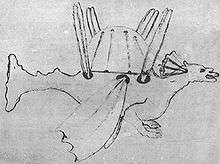Tito Livio Burattini

Tito Livio Burattini (Polish: Tytus Liwiusz Burattini, 8 March 1617 – 17 November 1681) was an inventor, architect, Egyptologist, scientist, instrument-maker, traveller, engineer, and nobleman.[1][2][3] He was born in Agordo, Italy, and studied in Padua and Venice. In 1639, he explored the Great Pyramid of Giza with English mathematician John Greaves;[3][4] both Burattini and Sir Isaac Newton used measurements made by Greaves in an attempt to accurately determine the circumference of the earth.[5]
For Germany in 1641, the court of King Władysław IV invited him to Poland. In Warsaw, Burattini built a model aircraft with four fixed glider wings in 1647.[2] Described as "four pairs of wings attached to an elaborate 'dragon'", it was said to have successfully lifted a cat in 1648 but not Burattini himself.[6] According to Clive Hart's The Prehistory of Flight, he promised that "only the most minor injuries" would result from landing the craft.[7]
He later developed an early system of measurement based on time, similar to today's International System of Units; he published it in his book Misura universale (lit. "universal measure") in 1675 at Wilno.[4] His system includes the metro cattolico (lit. "catholic [i.e. universal] metre"), a unit of length equivalent to the length of a free seconds pendulum; it differs from the modern metre by half a centimetre.[8] He is considered the first to recommend the name metre for a unit of length.
Along with two others he met at Kraków, Burattini "performed optical experiments and contributed to the discovery of irregularities on the surface of Venus, comparable to those on the Moon".[9] He made lenses for microscopes and telescopes, and gave some of them to Cardinal Leopoldo de' Medici.[9] He is also credited with building a calculating machine, which he donated to Grand Duke Ferdinando II, that borrows from both a Blaise Pascal machine and Napier's rods.[10] He died in Kraków, aged 64.
See also
References
- ↑ Frysinger, James R. "SI Background". SI Guide. Archived from the original on 2006-10-10. Retrieved 2009-05-24.
- 1 2 Needham, Joseph (1965). Science and Civilisation in China. IV (part 2). p. 591. ISBN 978-0-521-05803-2.
- 1 2 Shalev, Zur (2005). "The Travel Notebooks of John Greaves". In Hamilton, Alastair; van den Boogert, Maurits H; Westerweel, Bart. The Republic of Letters and the Levant. Brill Publishers. p. 94. ISBN 978-90-04-14761-4.
- 1 2 Quarrie, Paul (2006). "The Scientific Library of the Earls of Macclesfield" (PDF). Notes and Records of the Royal Society. 20: 20. doi:10.1098/rsnr.2005.0124. ISSN 0035-9149.
- ↑ Mehler, Stephen S. (2001). The Land of Osiris: An Introduction to Khemitology. Adventures Unlimited Press. p. 26. ISBN 978-0-932813-58-9.
- ↑ Harrison, James Pinckney (2000). Mastering the Sky. Da Capo Press. p. 27. ISBN 978-1-885119-68-1.
- ↑ Qtd. in O'Conner, Patricia T. (1985-11-17). "In Short: Nonfiction; Man Was Meant to Fly, But Not at First". The New York Times. Retrieved 2009-05-24.
- ↑ Agnoli, Paolo; D'Agostini, Giulio (2005-01-25). "Why does the meter beat the second?". arXiv:physics/0412078
 .
. - 1 2 "Tito Livio Burattini". Institute and Museum of the History of Science - Multimedia Catalogue - Biographies. Retrieved 2009-05-24.
- ↑ "Tito Livio Burattini [attr.], Calculating machine". Institute and Museum of the History of Science - The Medici and Science. Retrieved 2009-05-24.
External links
| Wikimedia Commons has media related to Tito Livio Burattini. |
- "Story about Burattini's "Flying Dragon"". in the 9 May 1963 issue of Flight International
- Nuncius: Annali di Storia della Scienza, issue 1998, especially section titled "G. MONACO, Alcune considerazioni sul «Maximus tubus» di Hevelius."